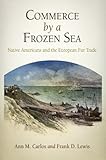Commerce by a Frozen Sea : Native Americans and the European Fur Trade / Frank D. Lewis, Ann M. Carlos.
Material type: TextPublisher: Philadelphia : University of Pennsylvania Press, [2011]Copyright date: ©2010Description: 1 online resource (272 p.) : 25 illusContent type:
TextPublisher: Philadelphia : University of Pennsylvania Press, [2011]Copyright date: ©2010Description: 1 online resource (272 p.) : 25 illusContent type: - 9780812242317
- 9780812204827
- Europeans -- Hudson Bay Region -- History
- Europeans -- Hudson Bay Region -- History
- Fur trade -- Hudson Bay Region -- History
- Fur trade -- Hudson Bay Region -- History
- Indians of North America -- Commerce -- Hudson Bay Region -- History
- Indians of North America -- Commerce
- Indians of North America -- Commerce -- Hudson Bay Region -- History
- American Studies
- HISTORY / United States / Colonial Period (1600-1775)
- American History
- American Studies
- Business
- Economics
- Native American Studies
- E98.C7 C375 2010eb
- online - DeGruyter
- Issued also in print.
| Item type | Current library | Call number | URL | Status | Notes | Barcode | |
|---|---|---|---|---|---|---|---|
 eBook
eBook
|
Biblioteca "Angelicum" Pont. Univ. S.Tommaso d'Aquino Nuvola online | online - DeGruyter (Browse shelf(Opens below)) | Online access | Not for loan (Accesso limitato) | Accesso per gli utenti autorizzati / Access for authorized users | (dgr)9780812204827 |
Frontmatter -- Contents -- Introduction. Native Americans and Europeans in the Eighteenth-Century Fur Trade -- Chapter 1. Hats and the European Fur Market -- Chapter 2. The Hudson's Bay Company and the Organization of the Fur Trade -- Chapter 3. Indians as Consumers -- Chapter 4. The Decline of Beaver Populations -- Chapter 5. Industrious Indians -- Chapter 6. Property Rights, Depletion, and Survival -- Chapter 7. Indians and the Fur Trade: A Golden Age? -- Epilogue. The Fur Trade and Economic Development -- Appendix A. Fur Prices, Beaver Skins Traded, and the Simulated Beaver Population at Fort Albany, York Factory, and Fort Churchill, 1700-1763 -- Appendix B. Simulating the Beaver Population -- Appendix C. A Model of Harvesting Large Game: Joint Ownership Versus Competition -- Appendix D. Food and the Relative Incomes of Native Americans and English Workers -- Notes -- Bibliography -- Index -- Acknowledgments
restricted access online access with authorization star
http://purl.org/coar/access_right/c_16ec
Commerce by a Frozen Sea is a cross-cultural study of a century of contact between North American native peoples and Europeans. During the eighteenth century, the natives of the Hudson Bay lowlands and their European trading partners were brought together by an increasingly popular trade in furs, destined for the hat and fur markets of Europe. Native Americans were the sole trappers of furs, which they traded to English and French merchants. The trade gave Native Americans access to new European technologies that were integrated into Indian lifeways. What emerges from this detailed exploration is a story of two equal partners involved in a mutually beneficial trade.Drawing on more than seventy years of trade records from the archives of the Hudson's Bay Company, economic historians Ann M. Carlos and Frank D. Lewis critique and confront many of the myths commonly held about the nature and impact of commercial trade. Extensively documented are the ways in which natives transformed the trading environment and determined the range of goods offered to them. Natives were effective bargainers who demanded practical items such as firearms, kettles, and blankets as well as luxuries like cloth, jewelry, and tobacco-goods similar to those purchased by Europeans. Surprisingly little alcohol was traded. Indeed, Commerce by a Frozen Sea shows that natives were industrious people who achieved a standard of living above that of most workers in Europe. Although they later fell behind, the eighteenth century was, for Native Americans, a golden age.
Issued also in print.
Mode of access: Internet via World Wide Web.
In English.
Description based on online resource; title from PDF title page (publisher's Web site, viewed 24. Apr 2022)


